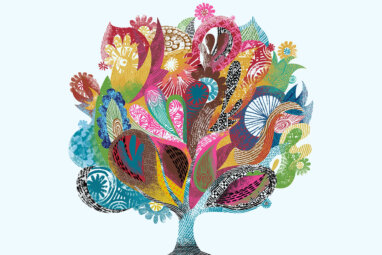Make Character Count in Hiring and Promoting
Most managers focus on competencies when evaluating candidates — but it’s character that will transform the DNA of the organization. Here’s how to assess it.
Topics

Jing Jing Tsong/theispot.com
It’s been said that we hire for competence and fire for character. Consider Boeing, which has been brought low by poor leadership decisions that have severely compromised its planes’ quality and safety, and hence public trust, forcing its CEO to announce a year-end departure. And yet the debate about who should be the next CEO of the troubled airplane manufacturer has centered on the merits of engineers versus accountants — that is, competencies. Missing from the conversation is the recognition that what’s needed is a leader with strong character-based judgment. As potential new leaders have been discussed, there’s been no talk of relative strengths or weaknesses in character.
While managers often think that they hire for character, most have equated character with values fit. They’ve tended to give too much weight to character dimensions such as drive and accountability and too little to humility and temperance — which can result in bringing toxicity and weak judgment into the DNA of the organization. That often prompts individuals with strong character to either leave the organization or disengage. This is especially so when yet another high-profile promotion signals that the organization values a limited or unbalanced set of character behaviors.
There’s no doubt that hiring, firing, and promotion fundamentally shape the culture of an organization for better and worse. Simply put, organizational culture reflects the character of individuals within it. Therefore, attending to character is a real leverage point. Having worked with many organizations seeking to elevate character alongside competence in their HR practices, I can share some key lessons.
Understand the Differences Between Competence and Character
Many people think they are assessing character when considering candidates for hire or promotion because they assess some isolated elements of character, such as courage, along with traditional knowledge, skills, and abilities. However, this is a severely limited perspective: Research has shown that character comprises 11 interconnected dimensions, with an associated set of observable behaviors. (See “Leader Character Framework.”) And character can be developed, as explained in an earlier article I coauthored in MIT Sloan Management Review.1 The critical point is to assess character comprehensively rather than simply naming a few qualities thought to be desirable in isolation. This is because any of the character dimensions will manifest as a vice if not supported by the other dimensions. Emphasizing courage and not humility is one example of where things can go off the rails. If high levels of courage are unrestrained by strength in humility, the result can be a tendency toward reckless judgment.
Elevating assessments of character to the same level of importance as assessments of competencies requires an appreciation for how these processes differ. Research has found that unlike competencies, which vary between organizations and often between levels of the organization, character attributes are universal.2 And while competencies may be evaluated independently of each other, character attributes are interconnected and need to be considered holistically. To do this well, hiring managers and HR leaders need to understand what character is, how it manifests, and how it can be developed.
The critical point is to assess character comprehensively rather than simply naming a few qualities thought to be desirable in isolation.
When hiring based on competence, the classic approach is to use structured interviews and associated assessment rubrics to evaluate what someone can do or how they would do it. Every person being interviewed during a particular process is assessed in the same way to minimize interviewer bias and foster objectivity. In contrast, character is about who someone is and how they became that person and thus is unique to the individual. There isn’t a one-size-fits-all approach, with a standard list of questions, for evaluating someone’s character. Instead, character assessments are more free-flowing and personalized conversations. They are objective and rigorous yet also honor individual differences.
The rigor and objectivity come from the extensive science revealing what character is, how it can be assessed and developed, and how it can be embedded in organizations, including HR practices. The individual differences arise because every person’s life story is different when it comes to the development of their character — and we can honor that uniqueness. Because character is not static but is a habit being developed over a person’s lifetime, assessment of character can be ongoing and repeated, whether it be in hiring or promotion decisions.
Conducting Character Interviews
Assessing character as part of the process of evaluating job candidates needs to occur separately from assessing competencies because it requires a more conversational approach than a typical interview. The following are the key considerations to keep in mind.
Prepare for character interviews by developing your own character. One of the reasons people struggle to assess character is that most of us operate with a pretty superficial and unsophisticated understanding of it, which often leads to our own imbalances. Part of the development of character is observing it in others and witnessing examples of how deficiencies and excesses manifest in certain choices and behaviors. As many people find, once they see it, they can’t unsee it. But seeing it often requires us to recognize our unexamined biases. Consider, for example, the dimension of justice: how someone cultivates a sense of what is fair and equitable will be shaped by their position within systems that have tended to privilege some people and undermine others.
Treat a character interview as a conversation. I’ve conducted a lot of character-based interviews with prospective athletes, such as during the National Hockey League Combine, where teams get to interview players before the draft. In one case, I met a coach and a prospect for a varsity team for such an interview; after about 30 minutes, I was ready to wrap up. The player was a bit surprised and asked whether I would be interviewing her, and the coach responded, “I think she just did.” It was such a genuine and interesting conversation with the player that it didn’t feel like an interview but rather simply like getting to know the person better.
Understand that the interviewer’s character is revealed as well as the interviewee’s. It’s not uncommon to hear that people being interviewed were so impressed by the interviewer that it really sold them on joining the organization. However, the opposite can also happen. How many organizations turn off prospective candidates because their interviewers reveal some degree of imbalanced character? Consider the character behavior of being interconnected (part of the dimension of collaboration), which is defined as “recognizing and valuing deep connections with others at all levels within the organization and society.” Cultivating the capacity to be interconnected is one of the key behaviors that helps to channel our empathy, compassion, open-mindedness, and flexibility to begin to relate to another person and have them trust us in the process. How interconnected can you be as you enter the conversation? Is this a behavior you’ve exercised in the past? If so, it will come naturally to you. If not, you’ll have some distance that will be more difficult to close, but it can be done. Think about the behaviors associated with curiosity, respect, and vulnerability (as part of humility) and how they’ll serve you as you explore the conversation. Behaviors such as thinking critically and demonstrating adaptability (part of judgment) will help you process the unfolding story.
Use probing questions. It doesn’t matter where you start because character interviews are like the proverbial peeling of an onion, with layers emerging as you explore the person’s background. For example, if you were to start with a broad question like “Why does the position interest you?” you would then pick up on the various threads that would allow you to explore the dimensions of character. If a candidate talked about how innovative the organization is and how much they enjoy being innovative, the questions could pursue where those interests come from and the major influences that have shaped the person. Those responses then become stepping stones to explore other parts of the candidate’s story. At no time are you asking directly about the dimensions of character; rather, you’re having a general conversation with the person about themselves.
Observe the clusters of dimensions and their strengths and weaknesses. Just as we would observe several dimensions of character operating simultaneously in our own lives, we can observe the same during an interview. I was conducting a mock interview in a training session, helping individuals understand what a character conversation looks like. The conversation quickly revealed the immense drive of the volunteer interviewee, and so my probing questions were around discovering more about her temperance and whether and how she had cultivated the patience and calm to support her drive. I asked how she typically handled frustrations and obstacles in her way. Instead of revealing aspects of patience and calm, she naturally began talking about elements of humanity and collaboration, and so I went with that flow. She described what she’d learned about herself “as a constant work in progress” and shared that, at her best, her instincts were to be a bridge builder. She explained that when she listened to people’s stories, she was able to find common ground to unite them in spite of their differences. After the 10-minute mock interview, I asked the 20 observers to meet in small groups to discuss what they’d observed around her strength of character and to then consider the next question they would ask to explore any unexamined areas. There was unanimous agreement on what they saw and where they would go next, although the questions they would pose were very different. Everyone wanted to explore the dimension of temperance.
In the hundreds of interviews I’ve conducted alongside other interviewers, it’s been very rare that we haven’t had similar interpretations of the interviewee’s strengths and weaknesses of character. When there are discrepancies, interviewers can perform additional due diligence by speaking with references to explore areas of concern. Those providing the references typically don’t understand what character is or how it operates in excess or deficiency, and thus the interviewer must be knowledgeable about character to probe those points.
Look for signs of strengths and weaknesses in interviewees’ stories. In the previous example, the candidate’s story revealed a lot of drive, courage, and accountability. Throughout her life, she’d shouldered a lot of responsibility, and it was apparent that she’d done so with a lot of vitality. Her transcendence was also clearly on display because her experiences weren’t just about the weight she carried but who she was when she carried it — her sense of being purposeful, inspired, optimistic, creative, and future-oriented, for example. While these were the dimensions appearing in the first few minutes, the probing questions revealed a lot of collaboration, humanity, humility, and integrity. When an interviewer knows how the muscles of character operate, they can explore what muscles a person regularly flexes in their life and which ones they use less. In this candidate’s case, temperance was the weakest link. Her interview revealed that she was aware that she took on a lot and that at times she had been close to burnout but had learned a lot from those experiences.
Observe whether integrity and humility are on display. These conversations, which bring out a richness in people’s authentic experiences, are qualitatively different from competency interviews, which can often feel rehearsed and superficial. When a candidate is talking about themselves, there are several facets of character that are always on display. Within the dimension of integrity, you can observe their degree of authenticity, transparency, and candor. You can also observe humility and whether the person is reflective and self-aware. While cultivating self-awareness is critical, it’s also important to keep in mind that it can operate in an excess state as self-consciousness, and being too reflective can turn into ruminating. So even high levels of humility need the other dimensions of character to balance that strength.
I’m often asked whether someone who has higher self-awareness has an advantage in character interviews, and the answer is yes. Like all character behaviors, those associated with self-awareness affect the disposition to lead. For example, individuals who lack self-awareness, among other potential weak behaviors, will find their leadership ability compromised. I’m also asked whether someone who is comfortable talking about themselves has an advantage, and the answer is generally yes. But when someone’s responses seem like rehearsed stories, it indicates that they might not be willing to let people really “see” them — another important facet of leadership that’s often overlooked.
Choose two to four interviewers. Although character interviews can be conducted one-on-one, when others participate, they can provide a validity check on the observations of the lead interviewer and also help take the pressure off of them to ask all of the questions. Because of the unstructured nature of character interviews, it’s particularly helpful to have someone more experienced lead the interviews while others develop a comfort level with the format of a character interview. I recommend not taking notes during the interview and instead taking time immediately afterward to consolidate insights and feedback.
Determine the overall strength of character development based on the interview. After the interview, the interviewers should discuss and assess which of the following four categories the candidate falls into: strong on all dimensions, weak on all dimensions, unbalanced but has the self-awareness to close the gaps, and unbalanced and at risk of being entrenched in their behavior. Because explicit character development is rarely addressed in either educational or employment settings, it’s not surprising that many people may be weak in some areas. However, one interesting finding that has emerged from character research is that many people who have been marginalized by systems that disadvantage or repress them have actually had to successfully cultivate character to navigate those systems. I would expect to see a lot of unbalanced character when interviewing at senior levels because most organizations have a hard-wired emphasis on some dimensions and not others.
Provide feedback to the candidate after a character interview. When interviewers are able to share post-interview feedback, candidates generally receive it as helpful. Although feedback sessions are optional, many candidates take advantage of them to learn about how their character was viewed. One candidate said that throughout her career, she’d been told to tone herself down, but that didn’t help her understand what action she needed to take. She finally learned, in a character assessment context, that her high drive and courage needed to be more strongly supported by her humanity and temperance. Rather than toning down her drive, she understood that she needed to strengthen the latter dimensions.
Typically, the lead interviewer handles the feedback and relies on the summary notes the group agreed on during the interview debrief. The focus of the feedback is to share what the committee saw as strengths and also where they saw weaknesses. For example, during the debrief of the mock interview described earlier, the team reflected on what they saw — that the candidate revealed many strong dimensions of character through her story — and then explored areas that were weaker and the implications for how those imbalances could undermine her strengths.
Someone who reveals significant imbalances or weaknesses in an interview, or on the job, can work on strengthening those areas.
As in any feedback scenario, some people are ready to receive constructive criticism while others are not, and this in itself can be a reflection of character. It’s important to recognize that this feedback is about what was seen in the interview and isn’t intended to define the person. For example, someone who’s nervous and second-guessing what they’re saying and what the interviewer is looking for might not behave in a way that is authentic, transparent, and candid (behaviors associated with the dimension of integrity). Gaining the awareness that the natural stress of an interview context mirrors workplace stressors that can undermine someone’s character strengths can be an important insight for a candidate.
Finally, knowing that there is a clear pathway to help a person strengthen their character is important for them, personally and professionally. One of the most important research findings about character is that it can be developed: Someone who reveals significant imbalances or weaknesses in an interview, or on the job, can work on strengthening those areas. And while it can take a long time to develop new competencies, with character there can be quite a rapid course correction, particularly around imbalances, when a person is prepared to commit to their character development.
Considering Character in Talent Development
While I’ve focused here on assessing character in candidates new to an organization, such assessments are equally important when it comes to promoting individuals. In fact, promotions may send the stronger signal about what qualities the organization values, because the individuals being promoted are known to their colleagues, who have already formed opinions about their character based on their behavior.
Promotion decisions generally arise from an assessment of a person’s performance and their readiness to take on more responsibility; often, they focus on competence in terms of results that the individual has delivered. Here, too, we can include character. One organization I worked with used 360-degree assessments of character and competence to identify high-potential candidates for promotion. One assessment surfaced a highly competent leader who had strengths in many dimensions of character but was weak on humility, humanity, and collaboration. He was essentially the most competent person in the room and knew the technical side of the job inside and out. His development would depend on strengthening his weaker dimensions of character. He agreed to take an overseas posting in an area he didn’t know so that he’d have to lean more heavily on his humility, humanity, and collaboration in order to lead effectively. The experience helped strengthen his character to ready him for promotion.
While the kind of explicit consideration of character in hiring that’s described in this article is a fairly nascent practice, it can have significant payoffs. Elevating character alongside competence in organizations is associated with a greater return on assets, more effective leaders, greater psychological safety, and increased organizational commitment and work engagement. It offers the potential for a sustainable competitive advantage in the war for talent.
However, because few people understand the research-based view of what character is or how to develop it, they may react to these initiatives with uncertainty and trepidation. That should be a warning signal that it’s a blind spot for the organization. It’s easy to recognize and close gaps on competence, but many organizations have been flying blind on character. Character can transform the culture of an organization, for good or for bad, whether we engage with it or not. Bringing it into HR practices such as hiring and promotion gives managers the opportunity to make it an organizational asset.
References (2)
1. M. Crossan, W. Furlong, and R.D. Austin, “Make Leader Character Your Competitive Edge,” MIT Sloan Management Review 64, no. 2 (winter 2023): 40-47.
2. C. Peterson and M.E.P. Seligman, “Character Strengths and Virtues: A Handbook and Classification (Oxford University Press and the American Psychological Association, 2004).








